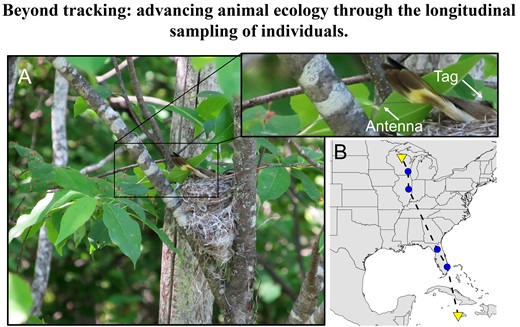-
Views
-
Cite
Cite
Bryant C Dossman, Emily Filiberti, Amber M Roth, Peter P Marra, Beyond tracking: Advancing animal ecology through the longitudinal sampling of individuals, Ornithology, Volume 142, Issue 1, 1 January 2025, ukae043, https://doi.org/10.1093/ornithology/ukae043
Close - Share Icon Share
ABSTRACT
Rarely, is there an opportunity to study and directly observe the same migratory animal across both breeding and nonbreeding seasons. In a rare, documented case, we highlight a live reencounter of a female Setophaga ruticilla (American Redstart) on its nest during the breeding season—an individual that was originally captured and tagged on its nonbreeding territory in Jamaica more than 3,250 km away. Advances in tracking technology allow researchers to track the movements of smaller organisms at higher resolutions. While tracking data alone have provided critical advances in the ecology of migratory animals, especially small migratory birds, there are exciting opportunities to move beyond tracking and to deeply explore biological questions about migratory animals by locating and directly studying (e.g., direct observation and physical sampling) the same individuals across the year. Although we have had the ability to precisely track large-bodied migratory birds (>100 g) for decades, researchers have rarely used these data to localize and directly observe or sample them across the year. Ultimately, we must consider the potential advances to be made in avian ecology through this endeavor. To this end, we highlight several specific areas of research that we believe move beyond tracking and can only be addressed by integrating direct longitudinal studies of individuals.
RESUMEN
Rara vez existe la oportunidad de estudiar y observar directamente al mismo animal migratorio tanto en las temporadas reproductivas como en las no reproductivas. En un caso raro y documentado, destacamos el reencuentro en vivo de una hembra de Setophaga ruticilla en su nido durante la temporada reproductiva—un individuo que fue originalmente capturado y marcado en su territorio no reproductivo en Jamaica, a más de 3.250 kilómetros de distancia. Los avances en la tecnología de seguimiento están permitiendo a los investigadores rastrear los movimientos de organismos cada vez más pequeños con resoluciones más altas. Aunque los datos de seguimiento por sí solos están proporcionando avances críticos en la ecología de los animales migratorios, especialmente las aves migratorias pequeñas, existen oportunidades emocionantes para ir más allá del seguimiento y explorar con profundidad preguntas biológicas sobre los animales migratorios al localizar y estudiar directamente (e.g., observación directa y muestreo físico) a los mismos individuos a lo largo del año. Aunque hemos tenido la capacidad de rastrear con precisión a aves migratorias de gran tamaño (>100 g) durante décadas, rara vez los investigadores han utilizado estos datos para localizar y observar o muestrear directamente a estas aves a lo largo del año. En última instancia, debemos considerar los avances potenciales que se pueden lograr en la ecología aviar a través de este esfuerzo. Con este fin, destacamos varias áreas específicas de investigación que creemos van más allá del seguimiento y que solo pueden abordarse integrando estudios longitudinales directos de individuos.

Lay Summary
• Here, we document a rare observation of a female Setophaga ruticilla (American Redstart) on her nest in northern Wisconsin that was originally captured and tagged on her nonbreeding territory in Jamaica more than 3,250 km away.
• As technology evolves and our ability to track smaller migrants for longer durations rapidly improves, these live reencounters will continue to become more common.
• Although tracking data alone provide critical advances in the ecology of migratory birds, we highlight several areas of research that we believe can only be addressed by directly studying and observing individuals repeatedly across the year.
• These longitudinal data will allow us to dive deeper into the ecology of migrants transforming our understanding of everything from individual behavior and physiology to population ecology and conservation.
• This single S. ruticilla observation serves as a timely reminder of the opportunities that in-depth longitudinal studies will provide toward ushering in new perspectives on longstanding issues and concepts long held as true in ornithology.





